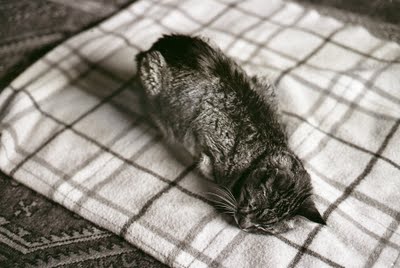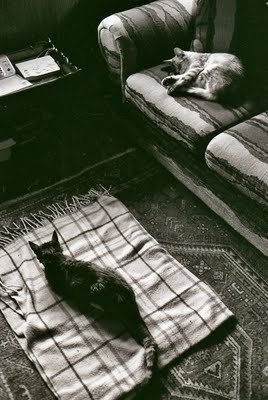Ireland Travel

On Thursday I had lunch (he bought) with Tim Bray (a computer language guru who parks his hat via online connections with Sun Microsystems) at Main Street’s Locus Restaurant. We have as I can see three things in common. We are both interested in photography, we both have blogs and we both write into them in a more or less random process. We diverge in that Bray’s ongoing (he is an amateur typographer who insists that the title of his blog should be in lower case) has upwards of 50,000 daily readers.
While my blog may be random in that I rarely know from one day to the next what the subsequent blog will be, once I choose a theme I stick to it even if I diverge a bit within it. Bray’s method is much more flexible. He rarely dates his postings which he calls fragments. He writes his fragments anytime he wants to, be it during the day or at night. He may write his fragments from Vancouver, from Tokyo or from Bremen. He often writes several of his fragments in one day. I find this method much more flexible when I realize I want to write about several disparate themes in one day. Such was the case on Saturday when we went to the Vancouver Aquarium. On the same day Toby our terminally ill cat seem to waver more so into that direction. We could see him fading. I decided to photograph him in the endearing way he sleeps with his head bent down at an angle in what looks like a complete and satisfying calm.

As Rebecca, Lauren Rosemary and I explored the Vancouver Aquarium on Saturday afternoon I remembered reading an essay in one of the Stephen Jay Gould books I have. The one that came to mind was from Dinosaur In A Haystack – Reflections in Natural History (19950). One of the essays is called Cabinet Museums : Alive, Alive, Oh! In it Gould explores the Dublin Museum of Natural History which opened in 1733 and after a royal charter in 1749 from George II, became a museum of the Victorian Age with full and systematic presentation made up of cast ironwork and dark wooden cabinets. In an earlier visit Gould had found the museum full of must and grime. It was an almost abandoned museum that had never quite moved up to Edwardian times. This time around (1993) Gould wrote:
“Not one jot of tittle of any exhibit had been altered, but all the surroundings had been meticulously restored to their original conditions – not just accurately by lovingly as well…The glass ceiling has been cleaned, and the light floods through. The dark wood of the cabinets has been repaired and polished and the glass now shines. The elaborate cast ironwork has been scraped and decorated in colorful patterns reminiscent of the “painted lady” Victorian houses of San Francisco. The ensemble now exudes pride in its own countenance – and I fully understood, viscerally, the coherent and admirable theory behind a classical Victorian “cabinet” museum of natural history.”
Of modern museums Gould writes:
“In choosing to construct a dynamic museums of museums, in asserting the old ideal of displaying nature’s full diversity, in restoring their interior space to Victorian intent in harmonizing architecture with organism, the curators of the Dublin have stood against modern trends in museums of science – where fewer specimens, more emphasis on overt pedagogy, and increasing focus on “interactive” display (meaning good and thoughtful rapport of visitor and object when done well, and glitzy, noisy, pushbutton-activated nonsense when done poorly) have become the norm.”
Gould finishes his essay controversially as he cites that word so difficult to defend in the 21st century. The word is elitism.
“I must therefore end with a point that may seem outstandingly “politically incorrect,” but worthy of strong defense nonetheless. We too often, and tragically, confuse our legitimate dislike of elitism as imposed limitation with an argument for leveling all concentrated excellence to least common denominator of maximal accessibility. A cabinet museum may never “play” to a majority of children. True majorities, in a TV-dominated and anti-intellectual age, may need sound bites and flashing lights - and I am not against supplying such lures if they draw children into even a transient concern with science. But every classroom has one Sacks [Oliver], Korn [Erik], or one Miller [Jonathan], usually a lonely child with a passionate curiosity about nature, and a zeal that overcomes pressures for conformity. Do not one in fifty deserve their institutions as well – magic places, like cabinet museums, that can spark the rare flame of genius?
Elitism is repulsive when based upon external and artificial limitations like race, gender or social class. Repulsive and utterly false – for that spark of genius is randomly distributed across al the cruel barriers of our social prejudice. We therefore must grant access – and encouragement – to everyone; and must be unceasingly vigilant, and tirelessly attentive, in providing such opportunities to all children. We will have no justice until this kind of equality can be attained. But if only a small minority respond, and these are our best and brightest of all races, classes, and genders, shall we deny them the pinnacle of their soul’s striving because al their colleagues prefer passivity and flashing lights? Let them lift their eyes to hills of books, and at least a few museums that display the full image of nature’s variety. What is wrong with this truly democratic form of elitism?”
My thoughts on Stephen Jay Gould’s defense of the cabinet museum came to mind when I compared the obvious delight of my granddaughters at the Vancouver Aquarium with the failure on our part to engage our two teenage daughters into being interested in the displays of the London Museum, the Prado in Madrid and the Louvre in Paris. This was back around 1984. I failed to interest my daughters in the original manuscript of Lewis Carroll’s Alice’s Adventures in Wonderland. I could not understand (I do so now) why they were not impressed by the letters from Admiral Horatio Nelson to his paramour Lady Hamilton; there, was his signature after a most un-heroic sounding, “yours, affectionately…”! Fortunately, both girls (grownup now) remember the magic of the special room at the Prado that houses Diego Velázquez’ Las Meninas.

In 2003 when we took Rebecca (she was 5) to Washington DC I changed my museum viewing tactics. In my living room I showed Rebecca a 4 Goyas. One David, one Da Vinci, one Winslow Homer ( Right and Left) and Degas’Little Dancer Aged Fourteen. That is all we saw. This worked as Rebecca has not been turned off to the joys of museum going. We subsequently visited museums in Buenos Aires, Guanajuato, Mérida and Morelia to her delight.

I can now add the Vancouver Aquarium to the list of museums that both our granddaughters enjoy.
My suspicions were confirmed when I looked up the origin of the word museum. As I had guessed it does have all to do with the nine muses. The word museum is from the Latin museum and this word from the Greek μουσεῖον (museion) which means the house of the muses.
Caliope: Epic Poetry
Clio: History
Erato: Lyric Poetry
Euterpe: Music
Melpomene: Tragedy
Polyhymnia: Pantomine
Thalia: Comedy
Terpsichore: Dance
Urania: Astronomy